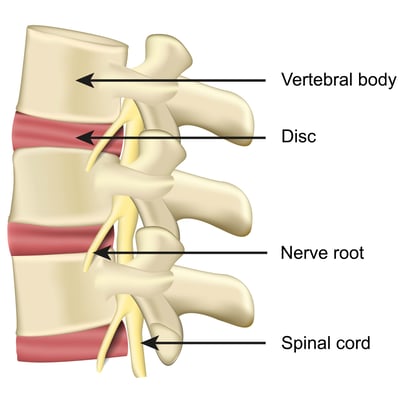What’s The Difference Between a Herniated Disc and a Bulging Disc?
Vertebral discs function as cushions for the spine's vertebrae. They are made up of an exterior layer of tough cartilage (annulus) surrounding the softer center (nucleus pulposus). You may imagine discs as miniature jelly doughnuts, fitting strictly between your vertebrae. With age, discs show signs of wear and tear.

With time discs may dehydrate and cause cartilage to stiffen. This transition can cause the outer layer of the disc to bulge outward around its circumference evenly and cause the space between discs to decrease. It appears like a hamburger too big for its bun.
Herniated Disc
A herniated disc occurs when the inner nucleus pushes through a tear in the protective annulus fibers. The area that this occurs can cause different symptoms depending on the structures in the area (spinal cord or spinal nerves). Herniated discs are often seen as more severe than bulging discs because they are no longer confined in the annulus fibers and can migrate further into other structures in the area. This could result in inflammation, severe pain in the extremities, and even difficulties in movement. Herniations can result from trauma, degeneration, unusual compression forces, desiccation, or lifting heavy objects (turning while bending down is the most common).

Bulging Disc
A bulging disc results when an intervertebral disk in the spine bulges outside its usual location. It is usually perceived as "contained," implying the disc is still intact, and the nucleus is yet to leak out. There is no rupture or tear outside the disc's annular layer at this point. There may be some considerable pain or dysfunction since the disc is not in its average balance, shape, and height. If you don't treat bulging discs, further degeneration may occur.

What is the difference?
Bulging discs are more prevalent compared to herniated discs. In general, bulging discs do not have the annular tear so the disc is still contained. Either type can still protrude into the spinal canal and cause pressure or irritate the surrounding nerves. Acute pain and dysfunction are more prevalent in herniated discs but can occur in both.
Causes of Herniated and Bulging Disc
Causes of herniated and bulging discs are the same. Degeneration is the most typical cause. As you age, the discs in your spine often dehydrate and stiffen. As a result, the discs may be slightly compressed or flattened. Due to this reason, as we age, bulging/herniated discs are a common occurrence. Other causes are:
- Repetitive spinal stress
- Poor posture
- Spinal injury
- Improper lifting techniques
- Obesity
Treatment for Herniated and Bulging Discs
Bulging and herniated discs are diagnosable by a primary care physician, spine specialist, or a pain management doctor. The health professional will review your medical history, carry out a physical examination and ask for an imaging test, for example, x-ray or Magnetic Resonance Imaging (MRI). After diagnosis, you will likely begin with the most conservative treatment, for example, rest, physical therapy, or medication to mitigate the symptoms. Most of these symptoms can resolve within a few weeks of conservative treatment but may become chronic and have flare-ups occasionally. Severe cases can require some sort of surgical intervention.
Discectomy is the most typical surgical treatment for a herniated disc. This is a procedure with minimal invasion where the spine surgery specialist extracts the injured part of the disc. For disc problems in the neck, an anterior discectomy and fusion is the typical surgical procedure. In some instances, an artificial disc procedure may be necessary. A specialist performs a spinal discectomy to relieve pressure on the nerves, spinal cord, or cauda equina (nerves that leave the spinal cord between spaces in the bones of the spine to connect to other parts of the body).
You can also use spinal braces if you require additional support. These braces are non-narcotic, non-invasive, and are endorsed by medical experts. They combine support and compression for adequate trunk stability. In addition, braces assist patients to resume their daily routine with minimal worry and reduce the potential for further complications.
Let Us Support You
Using a brace is one of the most non-invasive treatments recommended by medical professionals to patients with herniated or bulging discs. At Elite Medical Supply, our braces are designed to increase comfort and enhance healing by limiting the range of motion while easing pain, pressure, and swelling. Contact us today for our staff to closely liaise with your healthcare provider to offer you the best brace or pain management solution.
Written by Elite Medical Supply of NY
Braces and Products Covered by Medicare
Browse ProductsRecent Posts
- Cervical Brachial Syndrome (Thoracic Outlet Syndrome): What You Need to Know
- Spinal Decompression at Home: What It Is, How It Works, and Whether It’s Right for You
- Manage Osteoarthritis Progression With a Quality Knee Brace
- Product Highlight: Aspen Active™ P-TLSO
- Understanding Radiculopathy: Causes, Symptoms, & Treatment Options
Topics
- Back Braces (39)
- Knee Braces (31)
- Medicare Beneficiaries (31)
- Pain (25)
- Non-Opioid (23)
- Medical Providers (19)
- Lower back pain (11)
- Product Highlight (11)
- Sciatica (11)
- Muscle Spasms (10)
- Decompression (9)
- Lumbago (8)
- Degenerative disc disease (6)
- Lumbar Spinal Stenosis (6)
- Spinal Stenosis (6)
- Working with your doctor (6)
- Fracture healing (5)
- Herniated Nucleus Pulposus (5)
- Bulging or herniated disc (4)
- Neuromuscular Electrical Stimulation (NMES) (4)
- Quadratus Lumborum Syndrome (4)
- SI Joint (4)
- SI Joint Dysfunction (4)
- Spondylolysis (4)
- Wrist Pain (4)
- Bone Growth Stimulator Therapy (3)
- Bone Growth Stimulators (3)
- Carpal Tunnel Syndrome (3)
- Kyphosis (3)
- Supine Cervical Traction (3)
- Unicompartmental Osteoarthritis (OA) (3)
- Wrist Brace (3)
- wrist tendinitis (3)
- Ambulatory Cervical Traction (2)
- Braces for Golf (2)
- Cervical Traction (2)
- Electrical Stimulation (2)
- Failed Spinal Fusion Syndrome (2)
- Lumbar compression fractures (2)
- Radiculopathy (2)
- Spondylolisthesis (2)
- Total Knee Replacement (2)
- Wrist Braces (2)
- Arthritis (1)
- Braces for skiing (1)
- Cervical Brachial Syndrome (1)
- De Quervain Syndrome (1)
- Digital DME Orders (1)
- Knee Brace Accessory (1)
- Knee Suspension Wrap (1)
- Knee brace support for skiing (1)
- Medicare Scam (1)
- Muscle Atrophy (1)
- PCL (1)
- Patellofemoral Pain Syndrome (1)
- TLSO (1)
- Thoracic Outlet Syndrome (1)
- Ulnar Tendinitis (1)

